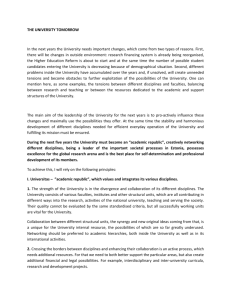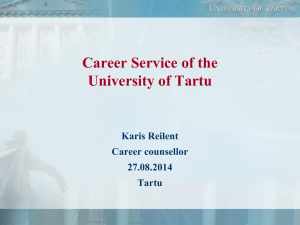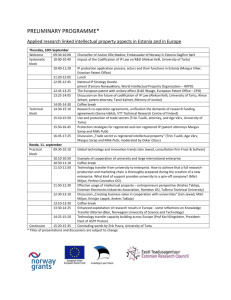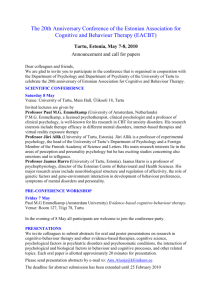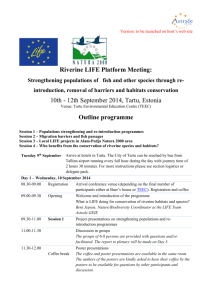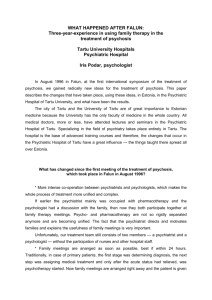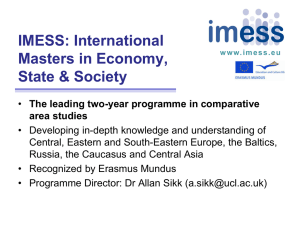History of Chemistry at Tartu University (1802-1919)
advertisement
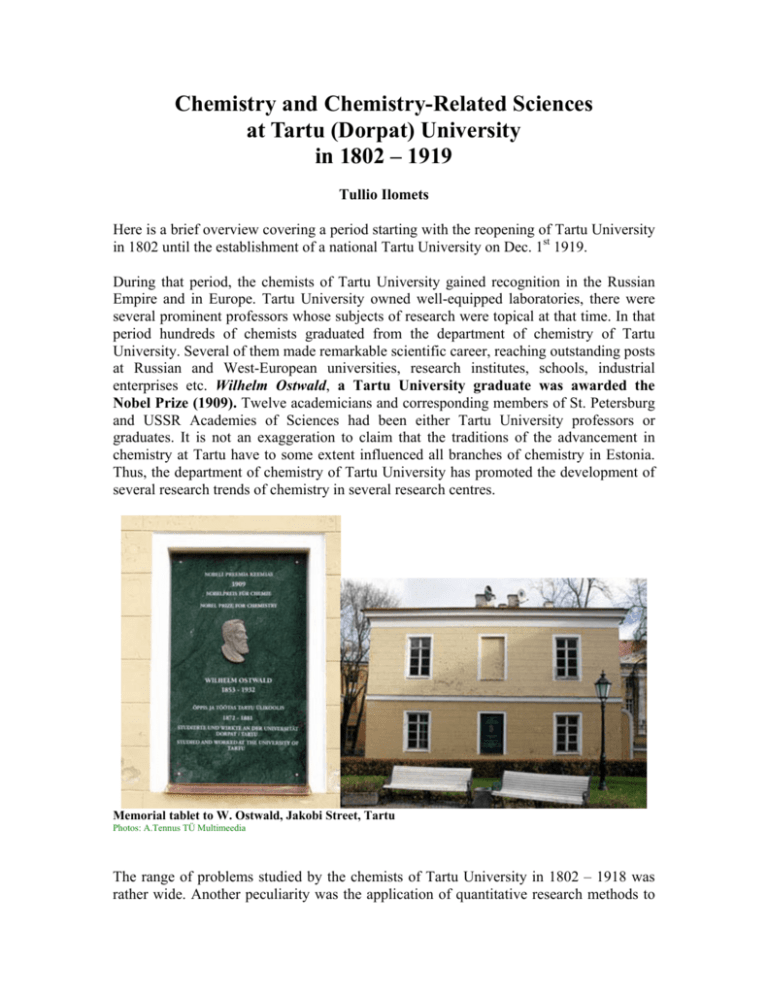
Chemistry and Chemistry-Related Sciences at Tartu (Dorpat) University in 1802 – 1919 Tullio Ilomets Here is a brief overview covering a period starting with the reopening of Tartu University in 1802 until the establishment of a national Tartu University on Dec. 1st 1919. During that period, the chemists of Tartu University gained recognition in the Russian Empire and in Europe. Tartu University owned well-equipped laboratories, there were several prominent professors whose subjects of research were topical at that time. In that period hundreds of chemists graduated from the department of chemistry of Tartu University. Several of them made remarkable scientific career, reaching outstanding posts at Russian and West-European universities, research institutes, schools, industrial enterprises etc. Wilhelm Ostwald, a Tartu University graduate was awarded the Nobel Prize (1909). Twelve academicians and corresponding members of St. Petersburg and USSR Academies of Sciences had been either Tartu University professors or graduates. It is not an exaggeration to claim that the traditions of the advancement in chemistry at Tartu have to some extent influenced all branches of chemistry in Estonia. Thus, the department of chemistry of Tartu University has promoted the development of several research trends of chemistry in several research centres. Memorial tablet to W. Ostwald, Jakobi Street, Tartu Photos: A.Tennus TÜ Multimeedia The range of problems studied by the chemists of Tartu University in 1802 – 1918 was rather wide. Another peculiarity was the application of quantitative research methods to neighbouring disciplines (especially to medicine) which promoted cooperation of different disciplines. The research subjects studied at Tartu were highly topical at that time. The scientists of our university had close contacts with the Academy of Sciences of St. Petersburg and other research institutions there, as well as with West-European scientific centres. Tartu University was an important mediator between the Eastern and Western sciences and cultures. After reopening of the University of Tartu in 1802, among the first professors there were several West-European scholars which brought along the ideas of the Enlightenment. Heinrich Gottlob Arzt (1766(7) – 1802), an alumnus of Jena University, was elected the first professor of chemistry and pharmacy of Tartu University. In 1802 he started the process of establishing a laboratory of chemistry, but his early death interrupted it. Alexander Nicolaus Scherer One of those prolific scientists was Alexander Nicolaus Scherer (1771 – 1824), a Jena University graduate. He was in fact the first professor of chemistry of the University of Tartu. In 1794 in Jena he had published a book “Grundzüge der neueren chemischen Theorie” propagating the ideas of Lavoisier’s new chemistry and criticizing Flogiston’s theory. Scherer laid a firm theoretical foundation of training chemists at Tartu University, setting up the Chemiekabinet and laboratory of chemistry. The next professor of chemistry and pharmacy was David Hieronymus Grindel (1776 – 1836), also a Jena graduate. He stayed in Tartu from 1804 until 1814. In 1810 –1812 he was the Rector of the University. During his professorship the organisation of the Chemisches Kabinet and laboratory of chemistry in the house of von Brandt was clompleted, and starting from 1809 David Hieronymus Chemisches Kabinet and laboratory were situated in the new main Grindel building of the University. D. H. Grindel moved to Riga, and in 1820 returned to Tartu to become a student of the Medical Faculty. Having been awarded a medical diploma in 1822 he practiced medicine and owned a pharmacy in Riga. The range of the topics of his research was wide and his literary and organisational activities extensive. Grindel was followed by JohannEmmanuel Ferdinand Giese (1781 – 1821), in Tartu 1814 – 1821, who had studied in Berlin and Augsburg. In 1817 – 1818 he was the Rector of the University. His research covered several branches of chemistry: general aspects of chemistry, then inorganic chemistry, organic chemistry, analytical chemistry, pharmaceutical chemistry and the history of chemistry. He wrote a fundamental 5-volume textbook of general chemistry, the first one in Russian. The textbook, published by Kharkov University in 1813 – 1817, become wideli used. Gise was also a pioneer in the research into the chemical composition of meteorites. Gottfried Wilhelm Osann (1797 – 1866) having previously worked at the universities of Erlangen and Jena, was active at Tartu University in 1823 – 1828. During that period he took a main interest in the chemistry of platinum metals. Gottfried Wilhelm Osann Carl Christian Traugott Friedemann Goebel The next scholar to hold the professorship of chemistry and pharmacy was Carl Christian Traugott Friedemann Goebel (1794 – 1851), a former extraordinary professor of pharmacy at the University of Jena, in Tartu 1828 – 1851. As all the above-mentioned professors had been either trained or had worked at the universities of Jena, Erlangen, and Erfurt of South-Germany, they brought along and introduced to Tartu University the ideas, philosophy, academic traditions prevailing at the turn of the 18th -- 19th centuries in Germany. By the way, they were also good acquaintances of Johann Wolfgang Goethe (1749 – 1832). After a long period of Goebel’s professorship, Carl Schmidt was appointed the professor of chemistry in 1852 when the department of chemistry was founded. On the initiative of C. Fr. Goebel, the Institute of Pharmacy was established in 1842. The first head of the institute was Carl Friedrich Siller (1801 – 1854, in Tartu 1843 – 1850). Goebel remained the professor of chemistry till his death, being also appointed the first professor of the Institute of Chemistry founded in 1850. Since then, the university has had the right to confirm diplomas in chemistry. The next professor of chemistry (1852) was Carl Ernst Heinrich Schmidt (1822 – 1894, at Tartu University 1846 – 1892). He was followed by his student Gustav Heinrich Apollon Tammann (1861 – 1938, professor at Tartu University in 1892 – 1904). In 1904 – 1908 Lev Pissarzhevski (1874 – 1938), W. Ostwald’s disciple, a later academician of the Academy of Sciences of the USSR, worked here. In 1908 – 1918 G.Tammann’s co-worker and a Tartu University graduate Alexander Bogoyavlenski (1868 – 1941) held a professorship of chemistry. After leaving Tartu, he was appointed the professor of organic chemistry at the University of Voronezh. Carl Friedrich Eduard Siller Carl Ernst Heinrich Schmidt Gustav Heinrich Apollon Tammann Lev Pissarzhevski Herman Hess Carl Ernst Claus Of those chemists who either studied or worked at Tartu University in the first half of the 19th century, we should mention St. Petersburg academician Herman Hess (1802 – 1850) who graduated from the university in 1825. Herman Hess was one of the founders of thermo-chemistry. He started his career as a chemist in the laboratory of Tartu University. We should also mention G. Osann’s research into the chemistry of platinum metals, though he did not finish it here. (G. Osann left Tartu for the University of Würzburg.). C. Fr. Goebel was interested in the same problem. He incited his student and assistant Carl Ernst Claus (1796 – 1864) to study this group of elements. Being a professor of chemistry at Kazan University (1839 – 1852) C. Claus discovered the element ruthenium. In Kazan the later world-famous specialist in organic chemistry, Alexander Butlerov (1828 – 1886) studied under his instruction. C. Claus founded an outstanding school of chemists of Kazan University. In 1852 – 1864 Claus was a professor of pharmacy and headed the Institute of Pharmacy in Tartu. The department of agriculture of the Faculty of Physics and Mathematics of Tartu University carried out studies in agroGeorg Paul Alexander chemistry. C. Fr. Goebel was an ardent supporter of Justus Petzholdt Liebig’s (1800 – 1870) views on agrochemistry. He wrote a monograph to promote spreading of Liebig’s ideas in Tartu. In 1845, after considering Goebel’s proposal, Georg Paul Alexander Petzholdt (1810 – 1889, in Tartu 1846 – 1872) was appointed the professor of agriculture. Petzholdt had studied at the universities of Leipzig, Berlin and Giessen under the instruction of professors Justus Liebig (Giessen) and Heinrich Rose (1795 – 1864) (Berlin). C. Schmidt had also been H. Rose’s and J. Liebig’s student. C. Schmidt studied at Berlin, Giessen and Göttingen Universities. His agrochemical studies ranged from fertilizers to soil analysis. Soil samples were brought from different places all over the Russian Empire. Schmidt’s another research field was hydrochemistry. He studied the waters of all parts of the world. He pioneered in hydrochemistry and his scientific papers have remarkably influenced the progress of this science. Carl Schmidt and Georg Dragendorff laid the foundation of the studies in the field of environmental chemistry and hygiene at Tartu University. Max von Pettenkofer’s (1818 – 1901) ideas must have also given an impetus to that research. Numerous doctor’s and master’s theses dealt with those problems. Classic studies in the field of the chemistry of silicates and phosphates, carried out by C. Schmidt and disciples Johann Lemberg, Hermann Benrath (1838 – 1885) and G. Tamman, form a special chapter in the progress of chemical research at Tartu University. Wilhelm Friedrich Ostwald (1853 – 1932) was certainly the most outstanding disciple of C. Schmidt. He studied at Tartu University in 1872 – 1875 majoring in chemistry. Ostwald defended here his master’s and doctor’s dissertations and he worked in Tartu until 1881, leaving for Riga and later on for Leipzig. In Tartu W. Ostwald’s studies concentrated on the equilibrium and affinity of chemical reactions (in his choice of research subjects he drew Wilhelm Friedrich inspiration from J. Lemberg’s lectures). Another C. Schmidt’s Ostwald student who gained international recognition was Gustav Tammann. In 1882, after graduating form the department of chemistry he became C. Schmidt’s lab assistant. In Tartu he was also awarded master’s and doctor’s degrees. In 1892 Russian was to be adopted as the language of tuition instead of German. Carl Schmidt retired and his post was given to G. Tammann. During his Tartu period Tammann studied the problems of heterogeneous equilibrium and phase transition kinetics. He also wrote a treatise on the kinetics of ferments. He had lots of disciples both in Tartu and Göttingen. (G.Tammann left Tartu for the University of Göttingen.) Vassili Borodovski(1878 – 1914), a student of G.Tammann, in1898 started studying chemistry and later continued working here up to 1912 when he left for St. Petersburg University. In his Tartu period he became the pioneer of radiochemistry in Tsarist Russia. Vassili Borodovski Johann Theodor Lemberg The third famous scholar who had studied under Carl Schmidt was Johann Theodor Lemberg (1842 – 1902), professor of mineralogy in Tartu in 1865 – 1902). In 1861 – 1864 he studied chemistry at Tartu and obtained here his master’s and doctor’s degrees. Lemberg studied the transformations of silicates, applying exact experimental research methods. He was a mineralogist and a petrographer of international renown. His trend of research was carried on by Alexander Lagorio (1852 – 1923), in Tartu 1875 – 1880, who was appointed the professor of mineralogy at the University of Warsaw. Gustav Piers Alexander Bunge (1844 – 1920, in Tartu – 1872 – 1885), another Schmidt’s student studied nutrition physiology. In 1885 he was appointed professor of physiology at the University of Basel. He was a well-known biochemist, one of the pioneers of this field. Gustav Piers Alexander Bunge Nikolai Lunin Georg Friedrich Karl Heinrich Bidder Hermann Adolf Alexander Schmidt Rudolf Richard Buchheim He was the supervisor of Nikolai Lunin’s (1853 – 1937) doctoral dissertation. In his thesis Lunin proved that for normal life and functioning, the food we consume must contain a certain group of compounds that had not been discovered yet at that time. C. Schmidt himself had written some treatises on problems of physiological chemistry at the early stage of his stay in Tartu. Schmidt’s and Friedrich Bidder’s (1810 – 1894, at Tartu University 1834 – 1859) classical work about the digestive juices and metabolism, published in 1852, is generally known. C. Schmidt took an interest in physiological chemistry when he studied at Göttingen University under the instruction of the physiologist Rudolf Wagner (1805 – 1864) and the chemist Friedrich Wöhler (1800 – 1882). At Tartu University, the role of Carl Schmidt and his research was especially remarkable for the development of those sciences which were based on the application of quantitative chemical research methods. Alexander Schmidt (1831 – 1894), at the University from 1862 to 1894, was a graduate of Tartu University, a prominent hematologist, and the author of the fermentative theory of the coagulation of blood. He spent 1858 to 1862 studying in Berlin with the famous Felix HoppeSeyler (1825 – 1895), improving his knowledge of physiological chemistry and blood physiology, and 1866 and 1867 in Leipzig at the laboratory of Karl Ludwig (1816 1895), the founder of modern experimental physiology. His monographs “Hämatologische Studien” and “Weitere Beiträge zur Blurlehre” were published in 1865 and 1895, respectively. C. Schmidt`s studies had a particular effect on the success made by Rudolf Richard Buchheim (1820-1879, at Tartu University 1847-1867) in working out the trend of experimental pharmacology. He established the world`s first laboratory of experimental pharmacology during his first year at Tartu and the Institute of Experimental Pharmacology in 1860. In his laboratory he laid a foundation to the exact quantitative research methods in this branch of science and started using chemically pure active substances. In 1867 he left for Giessen. Johann Ernst Osvald Schmiedeberg Eduard Rudolf Kobert Peter Hermann Stillmark Johann Georg Noël Dragendorff His work was continued by his pupil Oswald Schmiedeberg (1838 – 1920), who had obtained both secondary and higher education in Tartu. One of Schmiedeberg`s most outstanding achievements during his period at Tartu was the treatise on the chemistry and pharmacology of muscarine, published in 1868. In 1872 he became the director of the newly founded Strasburg Institute of Pharmacology. Rudolf Kobert (1852 – 1922), at the University of Tartu from 1886 to 1897, was elected the director of the Institute of Pharmacology of Tartu University in 1886. He had graduated from Halle University and worked from 1880 to 1885 in Strassburg as an assistant of O. Schmiedeberg. Being a toxicologist of wide scope, he returned from Strassburg with his own subject of research, among which was an old problem that had attracted R. Buchheim during his Tartu period. The same subject had also been dealt with by O. Schmiedeberg`s team in Strassburg in the early 1880s. It was a problem of the nature and properties of a toxic component found in castor seeds and oil, since little was known about it. Under prof. R. Kobert`s supervision Peter Hermann Stillmark (1860 – 1923) in 1888 completed his doctoral thesis “ Ueber Ricin, ein giftiges Ferment aus den Samen von Ricinus comm. L. und einigen anderen Euphorbiaceen”. P. H. Stillmark succeeded in isolating a poisonous protein component, toxine, from castor beans which he named ricin. That event is internationally recognized as the birthday of a new branch of science called lectinology. A great contribution to the progress of certain branches of chemistry (chemistry of natural compounds, organic chemistry, analytical chemistry) was made by the Institute of Pharmacy. After having arrived in Tartu in 1852 C. Claus continued to deal with the problems of analytical chemistry. In this field, a new era started in 1864 when Johann Geog Noël Dragendorff (1836 – 1898, at Tartu University 1864 – 1894) left St. Petersburg and came to Tartu University. Dragendorff had studied at the universities of Rostock under Franz Ferdinand Schulze (1815 - 1873) and Heidelberg under Robert Bunsen (1811 – 1899). He was an eminent pharmacist, pharmacologist, toxicologist and chemist, an excellent specialist in organic and analytical chemistry, whose scope of research was almost as wide as that of C. Schmidt. In 1868 a monograph was issued on the separation and analysis of toxins, and 1882 a big reference book was published about the qualitative and quantitative analysis of plants. He had pupils and disciples both in Russia and several European countries. Ivan Kondakov During Russification period, G.Dragendorff was dismissed and Ivan Kondakov (1857 – 1931, in Tartu 1894 – 1918) from Warsaw was appointed head of the Institute of Pharmacy. Kondakov had studied at St. Petersburg University under professor Butlerov. At the Institute of Pharmacy, I. Kondakov concentrated only on the research into the synthesis of organic compounds; his main subjects being the chemistry of unsaturated compounds (Butlerov’s research subject) and of terpens (it was also the research subject of a Kazan University graduate Jegor Wagner (1849 – 1903), who worked at Warsaw University). Kondakov and his disciples gained a remarkable success in this field. It was Ivan Kondakov who in 1900 was the first to successfully synthesize synthetic rubber. Michael Tswett For a short period of 1917 – 1918, Michael Tswett (1872 – 1919), the inventor of the method of chromatographyc analysis, acted as the professor of botany and the director of the Botanical Garden of the Tartu University. The above-presented material is by no means an exhaustive study aimed at summing up the progress of research in the field of chemistry, describing the rise of new ideas and concepts, their advancement and spreading at Tartu University, as well as links between the University of Tartu and other universities and research centres. The present overview is just a scheme meant to illustrate the system of genealogy of science. Literature 1. Tullio Ilomets. The Development of Research in the Field of Chemistry at Tartu University and the Problems of Genealogy of Science. // Sydsvenska medicinhistoriska sällskapets årsskrift. Supplementum 17. 1992, 5 – 10. 2. Ilomets, T. Centenary of the Discovery of Lectins at Tartu University.// LectinsBiology, Biochemistry, Clinical Biochemistry. Vol 7. Sigma Chemical Company, St. Louis, Missoury USA 1990, 3 – 8. 3. Hödrejärv, H. History of Analytical Chemistry in Estonia (1800 – 1950). Fresenius J. Anal. Chem. 1997, 357, 191 – 196. 4. Tähepõld, L. , Ilomets, T. Gustav von Bunge, a Great Scientist and Teacher in the Development of Physiological and Pathological Chemistry. Proc. Estonian Acad. Sci. Humanities and Social Sciences. 1995, 44, 2, 138 – 159. 5. Evgenia M. Senchenkova. Michael Tswett – the Creator of Chromatography. Russian Academy of Sciences, Moscow 2003, pp 335+23. 6. Käbin, I. Die medizinische Forschung und Lehre an der Universität Dorpat/Tartu 1802 – 1940. Ergebnisse und Bedeutung für die Entwicklung der Medizin. // Sydsvenska medicinhistoriska sällskapets årsskrift. Supplementum 6, 1986, 628 S. 7. Roß, R. Stefan. Carl Schmidt (1822 – 1894) als physiologischer Chemiker. // Deutsch-russische Beziehungen in Medizin und Naturwissenschaften. Dietrich von Engelhardt und Ingrid Kästner (Hgg). Bd. 6. Shaker Verlag, Aachen 2002, 159 – 189. 8. Bettin, H. Alexander Nicolaus Scherer (1771 – 1824) und das Verhältnis von Theorie und Praxis in der Chemie. // Deutsch-russische Beziehungen in Medicin und Naturwissenschaften. Dietrich von Enghelhardt und Ingrid Kästner (Hgg). Bd. 6. Shaker Verlag, Aachen 2002, 39 – 56. 9. Tammann, G. Ocherki razvitija himicheskoi laboratorij Derptsko-Jurjevskago Universiteta s 1802 po 1892 god. // Lomonossovskij Sbornik. Moskva 1901. 1 46 , (in Russian). 10. Stradyn. J. P. David Jeronim Grindel i ego nauchnoe nasledije. // Iz istorii jestestvoznanii i tehniki Pribaltiki. T. 6. Riga, Zinatne 1980, 238 - 240, (in Russian). 11. Martinson, X. R. Stanovlenie himicheskoi nauki i promõshlennosti v Estonii. Tallinn, Valgus 1987, 362 str. (in Russian). 12. Palm, U., Past, V. O. O nekotorõh napravlenijah razvitija teoreticheskoi himii v Tartuskom Universitete. Acta et comm. Univ. Tartuensis 219. Tartu 1968, 251 262, (in Russian). 13. Ilomets, T. Johann Georg Noël Dragendorff 150. Acta et comm. Univ. Tartuensis 743. Tartu 1986, 3 – 18 (in Russian). 14. Vello Past. Wilhelm Ostwald – a World Famous Physical Chemist. // Teaduse ajaloo lehekülgi Eestist XIII. Tartu 2004, 14 – 31, (in Estonian). 15. Tullio Ilomets. On the History of the Chemistry Department of Tartu University 1802 – 1919. Teaduse ajaloo lehekülgi Eestist XIII. Tartu 2004, 89 – 128, (in Estonian). 16. Karl Siilivask (editor). History of Tartu University II (1798 – 1918).Tallinn “Eesti Raamat” 1982, 430 (in Estonian). 17. Hödrejärv, Helvi. Gottfried Wilchelm Osann and ruthenium. Proc. Estonian Acad. Sci. Chem., 2004, 53, 3,125 - 144. 18. Vello Past, Hain Tankler. Chemie an der Universität Tartu/ Dorpat 1802 - 1918. 2007, Tartu. 196 S. + 42 Ill. 19. Vello Past, Tullio Ilomets, Hain Tankler. Chemistry and Pharmacy at the University of Tartu/Dorpat/Yurjev 1802 - 1918. 2009, Tartu. 316 pp + 63 ill. Prof. Carl Schmidt giving lecture in chemistry. Prof. Ivan Kondakov with pharmacy students. Kõik reprod: Andres Tennus, TÜ Multimeedia Opening the memorial tablet to W. Ostwaldi on October 17, 2003. Form left: Mayor of Tartu Mr. Andrus Ansip, Rector of the University of Tartu Prof. Jaak Aaviksoo, Dean of the Faculty of Physics and Chemistry Prof. Peeter Burk. Foto A.Tennus TÜ Multimeedia
